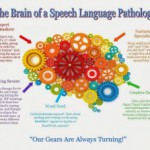 Normal language acquisition appears effortless (when everything is in good working order and development is ticking along).
Normal language acquisition appears effortless (when everything is in good working order and development is ticking along).
But as I often tell the parents of the children I work with, learning to talk is one of the most complicated things we learn to do.
When we talk, we need to organize our thoughts, find the right words, put them in the correct order with the correct grammar and then, our mouth, teeth, tongue respiration and vocal chords must all work together to get the message out. It is quite a tall order!
All children need support when learning to listen and speak. Here are my top 5 strategies speech therapists can use to support expressive language development in the children they work with.
1.Interact With the Child
Talk about what they are doing while they are doing it. First, the building block of language development is emotional connection. Most children want you to know what they are doing and that you approve. So smile, comment and say something like “What a great picture, tell me about it. Or “How did you make that man, why is he happy?”
Notice that this comment is open ended. This gives the child the opportunity to really let you know what is going on in their heads. Try to avoid excessive questions, this can put pressure on a child and make the interaction less spontaneous and authentic.
2. Model Good Speech
Show the child how to produce good speech by producing good speech yourself. When the child makes a mistake, i.e. “I throwed the ball”, you can restate the sentence correctly for the child by saying “You mean you threw the ball.” Don’t ask the child to repeat it correctly, this can make the child feel bad about the communication.
3. Expand on the Child’s Statements
If the child says “Ball”, you can say “Yes, a red ball.” Only add a little bit more information. You don’t want to overwhelm the child.
4. Use all Modes of Communication
Encourage your child to use gestures and signs. Children with expressive language delays often need to use more gestures, communication books and signs. This really helps words come out. Often when I have worked with adults after a stroke, they don’t gesture even though gesture words are often more easily expressed. This also is true for children.
5. Offer Choices and Cue the Child
For example when the child is stuck telling you what they want, you can show them choices and say, “do you want this or that?.” If they still have trouble, you can also say the beginning sound of the word to help them.
The next time you’re working with young ones, I hope these suggestions come in handy. Do you have a speech therapy tip based on your experience working with kids to help them express themselves better through language? If so, please leave it in the comments below!
About the Author
Sandra Alexander has over 20 years of experience in the speech therapy field. In 1994, she received her Master’s Degree in Communicative Disorders from San Diego State University and in 1985 she received a B.A. in Communicative Disorders from the University of Redlands. She is also a returned Peace Corps Volunteer who taught speech therapy in Ecuador from 1987-1989.







